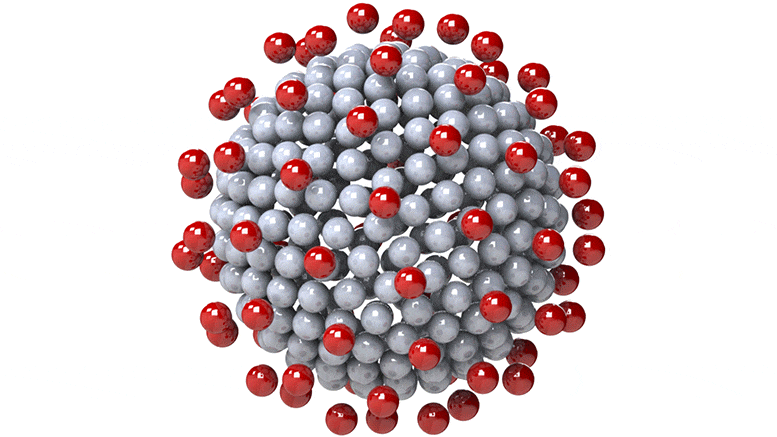Scientists in Japan Discover Key to Coronavirus Transmission: Triangular-Shaped Spikes
0 View
Share this Video
- Publish Date:
- 18 April, 2021
- Category:
- Covid
- Video License
- Standard License
- Imported From:
- Youtube
Tags

A more accurate picture of a coronavirus particle has triangular points. Scientists from OIST and Queen’s University have found that this can help the success of person-to-person transmission of the coronavirus. This image appeared in the research paper published in Physics of Fluids. Credit: This image appeared in the research paper published in Physics of Fluids
COVID-19 needs no introduction. Last year, the disease caused by the SARS-CoV-2 virus reached every continent around the world. By the end of March 2021, an estimated 128 million cases had been registered, of which nearly three million were fatal. As scientists race to develop vaccines and politicians coordinate their distribution, basic research is also being done on what makes this virus so successful.
Within the Mathematics, Mechanics and Materials unit of the Okinawa Institute of Science and Technology Graduate University (OIST), postdoctoral researcher Dr. Vikash Chaurasia and Professor Eliot Fried have used energy minimization techniques to look at charged proteins on biological particles. Previously, they did research on cholesterol molecules, but when the pandemic hit, they realized that they could be applied to the new virus with the methods they developed. They teamed up with researchers Mona Kanso and Professor Jeffrey Giacomin, from Queen’s University in Canada, to take a closer look at SARS-CoV-2 and see how the virus’s ” spikes ” (which officially become peplomeres) called) contribute to its success. in spreading so abundantly. Their study was recently published in Physics of Fluids.
“When one imagines a single coronavirus particle, it is common to think of a sphere with many spikes or smaller spheres scattered across the surface,” said Dr. Chaurasia. “This is how the virus was originally modeled. But this model is a rough draft, and over the past year we’ve learned a lot more about what the virus looks like. “
A more accurate picture of a coronavirus particle has triangular points. Scientists from OIST and Queen’s University have found that this can help the success of person-to-person transmission of the coronavirus. This image appeared in the research paper published in Physics of Fluids. Credit: This image appeared in the research paper published in Physics of Fluids
Instead, Dr. Chaurasia, the ‘spikes’ of the coronavirus particle are actually shaped like three small spheres stacked on top of each other to form a triangular shape. This is an important consideration because the shape of a viral particle can affect its ability to spread.
To understand this, imagine a ball moving through space. The ball will follow a turn, but as it does so, it will also turn. The speed at which the ball rotates is called the rotational diffusion. A particle of SARS-CoV-2 moves in the same way as this ball, although it floats in liquid (especially small droplets of saliva). The particle’s rotational diffusivity affects how well it can align with and attach to objects (such as a person’s tissues or cells) and this was key to its ability to spread so quickly from person to person. Higher rotational diffusivity means that the particle shakes and itches as it travels – so it can have a hard time attaching to objects or efficiently bouncing off an object to keep moving through the air. While a lower rotational diffusion has the opposite effect.
Another consideration was the charge of each peak. The researchers assumed that each is the same height. The same charges always repel each other, so if there are only two peaks on a particle and they have the same charges, they are at both poles (as far away from each other as possible). As more evenly charged peaks are added, they will be evenly distributed across the surface of the sphere. This provided the researchers with a geometric setup from which to calculate rotational diffusion.
Previously, the researchers looked at a viral particle with 74 spikes. For this new study, they used the same particle, but switched out the single-bead spikes for the three-ball triangles. When they did this, the particle’s rotational diffusivity was found to decrease by 39%. Moreover, this trend appeared to continue with the addition of more peaks.
This was an important finding: with a lower rotational diffusivity, the virus particles can align themselves better and attach themselves to objects and people. Thus, this study suggests that the triangular spikes contributed to the success of SARS-CoV-2.
“We know it’s more complicated than this,” explained Dr. Chaurasia. ‘The peaks may not be charged immediately. Or they can be flexible and twist themselves. Also, the ‘body’ of the particle may not be a sphere. So we plan to do more research in this area. “
Another interesting feature of this research is its connection to a question posed more than a century ago by physicist JJ Thomson, who investigated how a certain number of charges are distributed across a sphere.
“I find it fascinating that a problem considered over 100 years ago is so relevant to the current situation,” said Professor Eliot Fried. “Although this question was initially posed primarily out of curiosity and intellectual interest, it has turned out to be applicable in unexpected ways. This shows why we should not lose sight of the importance of basic research. “
Scientists at OIST and Queen’s University want to continue collaborating on this type of research to shed light on the success of SARS-CoV-2. Queen’s University researchers have just received a Mitacs Globalink Research Award to enable lead author Mona Kanso to travel between Canada and Japan and to work more closely with OIST.
Reference: “Peplomer Spherical Shape and Coronavirus Rotational Diffusivity” by MA Kanso, V. Chaurasia, E. Fried and AJ Giacomin, March 30, 2021, Physics of Fluids.
DOI: 10.1063 / 5.0048626










